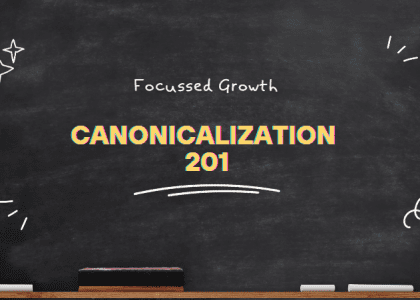SEO Specialist’s Wisdom: Writing the Perfect Blog
Over the years, I’ve learned that a truly effective blog post is more than just well-written paragraphs. It’s about the structural elements and strategic components that make readers want to stay, share, and come back for more.
Think of it this way: the difference between an average post and one that drives traffic and converts visitors often lies in the details. I’m excited to share my approach, as these tactics can dramatically improve your content’s performance.
When I started blogging, I focused solely on writing. But I quickly realized that even the most eloquent content needs optimization to gain traction. That’s why I studied successful blogs and identified twelve critical elements that form the foundation of every “perfect” high-performing blog post.
Essential Components to a Perfect Blog
SEO Metadata: Your First Impression ✓
Think of your blog’s metadata as its digital storefront—it’s the first thing potential readers see in search results! To make it irresistible:
Craft a compelling title that includes your target keywords and a subtle call-to-action (e.g., “12 Essential Tips for Blog Success”).
Write a meta description that acts like a mini-ad: highlight benefits, pose questions, or promise solutions (e.g., “Discover how to craft blog posts that drive traffic and engage readers”).
Keep your URL clean and keyword-rich—avoid dates or unnecessary numbers that might make your content look outdated.
Research shows that titles with numbers (like “12 Essential Elements”) and emotional triggers (“Perfect,” “Essential”) get more clicks. Also, meta descriptions that pose questions outperform generic summaries. I spend time refining these elements before publishing.
Schema Markup: The Hidden Advantage ✓
Schema markup might be invisible to readers, but it tells search engines exactly what your content is about. I implement Article, BlogPosting, and Breadcrumbs schemas on every post, which helps my content stand out in search results with rich snippets. I cannot stress this enough, without schema you are unlikely to have a perfect blog post that turns conversions!
Many bloggers skip schema markup because it seems technical. However, even basic implementation can give you a competitive edge. I noticed a big jump in click-through rates after adding schema markup to my posts. Plugins and tools make it easier than ever to implement.

Original Images: Visual Engagement ✓
I always include high-quality, original images throughout my content and add descriptive alt attributes to each image, which helps with SEO and accessibility.
Posts with custom graphics and relevant visuals get approximately 94% more views than those without.
Original images also provide branding opportunities and reduce copyright issues. I often create custom infographics that summarize key points, as these are highly shareable and generate valuable backlinks.

Content Length: Substance Matters ✓
I aim for a minimum of 700 words per post but adjust based on competitor content and the search query. Quality over quantity is key, ensuring every paragraph delivers value.
I’ve found that longer, comprehensive posts (1,500+ words) rank better for competitive keywords, while shorter posts (700-1,000 words) do well for long-tail queries. I always research competitor content before deciding on an appropriate length.
Table of Contents with Jump Links ✓
To improve navigation, I include a table of contents with jump links, structured to match common search patterns. This helps readers find information quickly and signals content organization to search engines.
Posts with a table of contents experience 16% lower bounce rates and 25% longer average session durations. Google sometimes uses these jump links to create enhanced search listings, which improves user experience.
Heading Structure: Clear Organization ✓
I use a proper heading hierarchy, starting with a single H1 tag for the main title, then H2s for major sections, and H3s/H4s for subsections. Each heading has supporting content beneath it, creating a logical flow.
Proper heading structure improves readability by breaking content into digestible chunks. It helps readers scan for relevant information, which is important since most online visitors skim content before deciding to read in depth. Also most importantly, it helps Google recognzie relevant keywords on each section of your page. So if you’re going to try and write a perfect blog post, make sure it’s perfect in Google eyes too!

Internal Links: Building Your Web ✓
I strategically place internal links throughout my content, selecting relevant connection points to other content on my site. This improves crawl efficiency and strengthens contextual relationships between pages.
My internal linking strategy follows two principles: relevance and user value. I only link to content that enhances the reader’s understanding and use descriptive anchor text. This creates a robust site architecture and encourages deeper exploration.
Product Card Embeds: Conversion Opportunities ✓
I embed relevant product cards within my content when appropriate. These aren’t just promotional elements—they’re carefully integrated solutions to problems discussed in the content.
Placement significantly impacts performance. Positioning product cards after explaining a problem—but before presenting the solution—yields the highest conversion rates. Cards with social proof elements like ratings or testimonials perform best. Thoughtful implementation of product cards can transform informational content into valuable conversion assets.
HTML Elements: Enhanced Readability ✓
I incorporate HTML elements such as lists, tables, and accordions to improve readability and increase the chances of capturing featured snippets in search results. This attention to formatting pays dividends in both user engagement and search visibility.
Lists and tables organize information in a scannable, user-friendly format and significantly increase the likelihood of winning featured snippets. Properly formatted lists have a 72% higher chance of appearing in featured snippets compared to paragraph text.
Bringing a Perfect Blog Post All Together:
YouTube Video Embed: Multi-Channel Engagement ✓
Whenever possible, I pair my blog posts with complementary YouTube videos. This not only increases time on page but also creates valuable backlink opportunities, extending content reach significantly.
The synergy between written and video content creates a powerful engagement loop. Viewers who discover my YouTube content often visit the blog for more information, while blog readers might watch the embedded video for visual demonstrations. This approach helps build a more engaged audience across multiple platforms.
CTA for Engagement: The Final Touch ✓
I conclude each post with a clear call-to-action that encourages reader engagement, such as inviting readers to comment, share, subscribe, or explore related content. These engagement signals strengthen the overall performance metrics of the blog.
Personalized, benefit-focused CTAs (“Share your experience to help others”) outperform generic requests (“Leave a comment below”). I often pose thought-provoking questions that encourage discussion. These engagement-focused CTAs sometimes perform better than direct conversion CTAs in terms of long-term audience building.
It’s debated around some circles if this is truly the key to creating the perfect blog post, but what’s held as consensus is that CTAs strategically placed at the right moments in your content can effectively move readers through the buyer’s journey and maximize impact.
“If this guide has sparked a new idea, pay it forward by sharing with a friend!”
Ready to Try Writing a Perfect Blog?
By methodically incorporating these twelve elements into every blog post, I’ve transformed my content from basic articles into comprehensive resources that perform well with both readers and search engines. This approach requires more effort but the results justify the investment. When you check off each item on this list, you’re not just writing content—you’re crafting an experience.
This framework is adaptable. While the core elements remain constant, their implementation can be tailored to suit different niches and audience preferences. Regularly analyzing performance data allows for continuous refinement and optimization. View this checklist not as a rigid formula but as a foundation upon which to build your unique content strategy.
What blog post elements have you found most effective in your own content creation journey? If you don’t know, you might want to take a strategy call with us!





